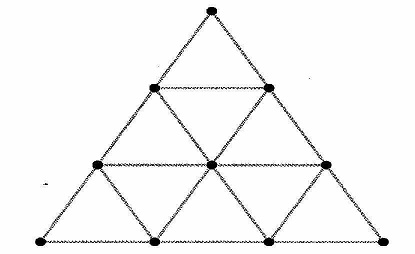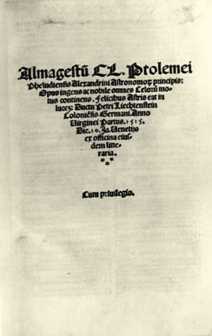by Alain Bougearel
The numerological structure of the Ttarot finds its first clear reference in the literary work of Boiardo, written between 1461 and 1494, probably in 1487, and in the so-called Sola-Busca Tarot, of the end of the XV century, standardizing definitively in the packs of the 16th century. This deck of 78 cards (22 Triumphs + 40 numeral cards (= 4 x 10) + 16 court cards = 4 x 4), would seem to derive from Pythagorean arithmology, since its relation with the Tetraktys is unequivocal.
The Pythagorean Tetraktys is composed of a triangle formed by four levels of respectively four, three, two points, then a single point on top. The total number of points is ten, and this number was considered the most perfect, as it is the sum of the first four (1 + 2 + 3 + 4). These four lines represented in physics the four elements, and in geometry the point, the line, the surface and the volume. The sides of the triangle are formed by four points each.

According to Pythagorean doctrine a number does not represent only an arithmetical entity, but is also a metaphysical principle of harmony that regulates the universe and what happens in it. So number becomes the essence of everything, the universal law that harmonizes and governs everything, the principle of everything.
As primeval element of the physical world, the point is seen to correspond to the unity from which by multiplication derive the different forms of harmony (such as Love, Beauty, Justice, etc.). Therefore Harmony appears as an ethical ideal of human conduct, the element of perfection to which humanity had to aim, to reunite, purified, with the great universal harmony.
The Pythagorean mathematicians were known since the Middle Ages in the Latin West especially because of Fibonacci and Leonardo of Pisa (1170-1250), intimates of Emperor Fredericck II, while their propagation had its greatest splendour during the Italian Renaissance, in particular because of erudite Byzantines and Florentine Neoplatonic syncretism. The presence of Neoplatonist elements in the Tarot has already been demonstrated elsewhere, starting with the iconography of various cards being modified at the end of the 15th century to adhere to this doctrine (1), continuing with the insertion into the so-called Tarot of Mantegna of images taken from the work De gentilium imaginibus deorum, by the hermetic poet Ludovico Lazzarelli, and ending by quoting the figures of an alchemical nature that we can find in the Sola-Busca Tarot.
In the Tarot the number 22 of the triumphs was originally conceived on the basis of mystical Christian numerology, to make humanity come to the contemplation of God (2), while 78 has extraordinary correspondences in Eastern mysticism that were later taken to the West according to the practice of the transmigration of symbols (3). By means of the concept of Pythagorean harmony (every structure well ordered in its parts and combined in proper proportion), it is possible to identify in the Tarot a harmonic structure that reprises the same themes of Christian mysticism, transfiguring them thanks to a renewed significance of Platonic character.
Central to Platonic philosophy is humanity’s relationship with other forms of life and the cosmos. Man, even if on the phenomenal level he is a weak and mortal creature, possesses an essential part, or soul, that constitutes a fragment of the divine universal soul, divided from the latter and imprisoned in a mortal body. The universe, in turn, is represented as supplied with an inner order (cosmos) and constituted by a living substance, eternal and divine. Thus humanity has to undergo a process of purification through a series of physical deaths and rebirths, to find again union with the universal soul. Studying the perfect structure of the universe, of which the orbits of the celestial bodies revolving in perfect circles are visible symbols, humans bring that order into themselves and conform their souls to it.
It is very important to consider how in Christian mysticism, Pythagorean thought and the Platonism that derives from it, the search of humanity for God – both as contemplation and as return to the original nature - is shown through recourse to the same numerological significations.
Coming to the number 78, corresponding to the sum of the cards in the Tarot, one can then note that it is the “Pythagorean sum” of the first 12 numbers:
The 78 cards = 1 + 2 + 3 + 4 + 5 + 6 + 7 + 8 + 9 + 10 + 11 + 12
which can be represented by a pyramid corresponding to the figure below:

This pyramid is composed of 16 honours or court cards (King, Queen, Knight and Page) = 4 x 4, which we can place at the top

In addition, it is composed of 40 numeral cards = 4 x 10, which we can put at the sides:

Finally, the 22 allegorical subjects or Triumphs = 1 + 4 + 7 + 10 form the three sides of the pyramid, which can be seen in the picture below.

So the pyramid appears complete with triumphs, numeral and court cards:

A triangle with base 12 can be found on the first page of the Almagest of Ptolemy in the version of Venice, 1515. In this work the author, conceiving the Earth as motionless in the center of the universe, describes in geometrical and mathematical terms the motions and positions of the planets, Sun and Moon on the background of the fixed stars. The presence of this pyramid, even if turned upside down, testifies to the evident influence of the Pythagorean arithmology upon which many scientists of that age drew.

At this point we might wonder what the mystical significance was of the number 56 that, united with the 22, appears in the structure of the Tarot.
The numbers that need to be taken in consideration are 10 (numeral cards) and 4 (court cards), both multiplied by 4 on the basis of the number of suits. If 10, as we have seen, was considered the most perfect number, in 4 we find the expression of materiality, in the way it is expressed in the sensible world, i.e. the seasons, humours, winds, elements, etc.
The 56, which results from the multiplication of 10 and 4 by the four suits, represented for the Rosicrucians the number of alchemy (4). The number 78, union of 56 and 22, conceals therefore a Pythagorean arithmology that reveals there the divine perfection (the number 10), human nature (the 4) and the path of humanity to reach such perfection (22). The number 12, by means of which the 78 form the Pythagorean pyramid, indicates in its tota a complete cosmic cycle, represented symbolically by the signs of the zodiac: a path that proclaims, in philosophical terms, a matrix of Neopythagorean and Platonic character.
The complete series of Arithmological Structure of Tarot are on: